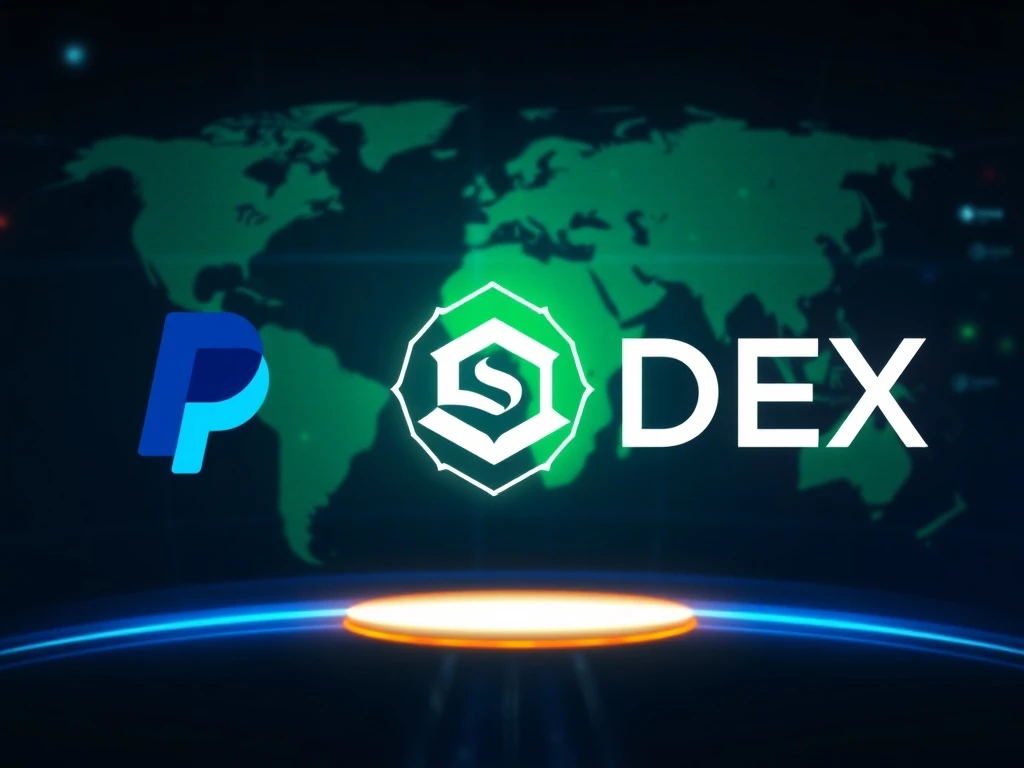Paxos USDH Bid Secures Pivotal PayPal Crypto Integration for Hyperliquid’s Future

The landscape of decentralized finance (DeFi) is constantly evolving, with stablecoins at its core. A significant development has emerged as Paxos, a regulated blockchain infrastructure platform, dramatically updated its proposal to issue Hyperliquid’s USDH stablecoin. This revised bid includes a groundbreaking partnership with PayPal, promising a new era for Paxos USDH and the broader DeFi ecosystem. This move could redefine how users interact with digital assets, especially concerning mainstream financial services. It represents a crucial step towards bridging traditional finance with the innovative world of cryptocurrencies, setting a new standard for accessibility and integration.
Paxos USDH and the Power of PayPal Crypto Integration
Paxos has significantly enhanced its proposal to issue USDH, the stablecoin planned for the Hyperliquid decentralized exchange (DEX). On Wednesday, Paxos unveiled a strategic alliance that promises to transform the stablecoin’s reach. PayPal, a global leader in online payments, has committed to supporting the Hyperliquid ecosystem. This commitment brings a suite of powerful integrations and incentives. Essentially, PayPal will list the HYPE token, Hyperliquid’s native asset, on its platforms. Furthermore, it will offer free on and off-ramps for the new stablecoin, making it easier for users to convert traditional currency to USDH and vice versa. This is a monumental step for widespread adoption. PayPal will also support both USDH and HYPE for PayPal Checkout, allowing these digital assets to be used for everyday purchases. Moreover, PayPal has pledged a substantial $20 million in incentives, directly bolstering the HYPE ecosystem. Perhaps most notably, PayPal plans to integrate USDH into its popular payment app, Venmo, and its international money remittance service, Xoom. This extensive PayPal Crypto Integration could expose USDH to millions of users globally.
Global Reach and Regulatory Standing
Beyond the PayPal collaboration, Paxos highlights its strong regulatory standing within the European Union. This positioning allows its stablecoin to circulate seamlessly across European markets. Consequently, USDH can scale globally, addressing a critical need for stablecoins seeking broad adoption. This regulatory clarity provides a distinct advantage in an increasingly scrutinized market. Paxos’ ability to navigate complex regulatory frameworks ensures that USDH is not just technologically advanced but also compliant and accessible across diverse jurisdictions.
Hyperliquid Stablecoin: A Growth-Oriented Revenue Model
Paxos’ updated proposal intricately ties its financial success to the growth of the Hyperliquid ecosystem. This alignment ensures that “Paxos only wins if Hyperliquid wins.” This commitment is reflected in a unique revenue model. Paxos will not take any fees until Hyperliquid reaches $1 billion in Total Value Locked (TVL). After this initial milestone, Paxos begins earning 1% of the fees. This percentage scales up progressively, capping at 5% once Hyperliquid’s TVL reaches $5 billion or greater. Importantly, any fees earned by Paxos through this milestone will be held in HYPE tokens. This mechanism further aligns Paxos’ interests with the long-term success and value appreciation of the Hyperliquid Stablecoin and its ecosystem.
The incentives structure is designed to foster sustainable growth:
- Initial Phases (Up to $1B TVL): Up to 80% of funds are dedicated to ecosystem development. This ensures robust growth during the critical early stages.
- Scaling Phases ($1B to $5B+ TVL): As TVL increases, the percentage allocated to ecosystem development gradually decreases to 25%. More funds are then directed towards Hyperliquid’s Assistance Fund treasury.
The Assistance Fund is a protocol-owned treasury. It receives platform revenues and fees, which it uses to market-buy HYPE tokens. This mechanism acts as both a buyback program and an insurance fund for the ecosystem, providing stability and supporting the token’s value. This thoughtful distribution ensures resources are allocated effectively at each stage of Hyperliquid’s development.

Intense Competition in the Stablecoin Market
The race to issue USDH has intensified significantly, with multiple prominent firms vying for the opportunity. Paxos’ updated bid with PayPal integration certainly raises the stakes. However, it faces formidable competition. On Monday, a coalition of crypto firms, including MoonPay, Agora, and Rain, submitted a joint proposal. They directly opposed a separate proposal from an entity indirectly controlled by the financial giant Stripe. Agora CEO Nick Van Eck voiced concerns, warning that Stripe’s vertical integration presented “clear conflicts of interest.” This highlights the ongoing debate around centralization and potential monopolistic practices within the crypto space.
Adding to the competitive mix, Ethena Labs emerged as the sixth bidder for Hyperliquid’s USDH stablecoin on Tuesday. Ethena Labs, the team behind the USDe and USDtb stablecoins, proposes backing USDH with its USDtb stablecoin. This USDtb stablecoin is notably tied to BlackRock’s BUIDL fund, adding another layer of institutional backing and complexity to the proposals. The diverse approaches and significant players involved underscore the strategic importance of issuing a new, widely adopted stablecoin. This fierce competition ultimately benefits the Hyperliquid ecosystem, as each bidder brings unique strengths and value propositions to the table, showcasing the dynamic nature of the Stablecoin Market.
DeFi Payments: Redefining Accessibility and Utility
The potential integration of USDH into PayPal, Venmo, and Xoom represents a monumental leap for DeFi Payments. Currently, engaging with decentralized finance often involves navigating complex on-ramps and off-ramps, limiting mainstream adoption. PayPal’s involvement could dramatically simplify this process. Users could seamlessly move funds from their traditional bank accounts into USDH within familiar apps like Venmo. This integration removes significant barriers to entry, making DeFi more accessible to a broader audience. Imagine using USDH for international remittances via Xoom, combining the efficiency of blockchain with the convenience of a trusted financial service. Such developments not only enhance the utility of stablecoins but also push the boundaries of what is possible in digital payments. It suggests a future where the lines between traditional finance and decentralized finance become increasingly blurred, benefiting consumers and businesses alike through greater efficiency and lower costs.
The Broader Implications for the Crypto Ecosystem
Paxos’ renewed push for a US bank license, as stablecoin rules continue to take shape, further emphasizes its commitment to regulatory compliance and mainstream integration. The firm’s past settlement with the New York regulator over its Binance partnership also demonstrates its experience in navigating regulatory challenges. These efforts are crucial for building trust and legitimacy in the evolving crypto landscape. The battle for USDH is not just about a single stablecoin; it reflects a broader trend. Crypto companies are increasingly seeking to integrate with established financial systems. This convergence could unlock unprecedented liquidity and user adoption for decentralized applications. Ultimately, the success of USDH and similar projects will depend on their ability to offer superior utility, maintain robust security, and achieve widespread acceptance through strategic partnerships and clear regulatory frameworks.
Conclusion: A New Era for Stablecoins and DeFi
Paxos’ updated bid for Hyperliquid’s USDH stablecoin, significantly bolstered by PayPal and Venmo integration plans, marks a pivotal moment in the cryptocurrency industry. This collaboration has the potential to dramatically enhance the accessibility and utility of stablecoins, driving broader adoption of DeFi payments. The innovative revenue model, which ties Paxos’ success directly to Hyperliquid’s growth, showcases a forward-thinking approach to ecosystem development. Furthermore, the intense competition among leading firms to issue USDH underscores the growing importance of stablecoins in the global financial landscape. As the Stablecoin Market continues to mature, strategic partnerships and regulatory clarity will be key determinants of success. The future of decentralized finance looks increasingly integrated, with mainstream platforms playing a crucial role in bringing crypto to the masses. This development sets a powerful precedent for how traditional financial giants can collaborate with blockchain innovators to build a more connected and efficient global economy.








